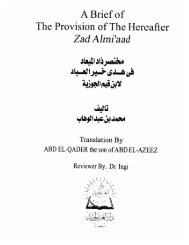You also want an ePaper? Increase the reach of your titles
YUMPU automatically turns print PDFs into web optimized ePapers that Google loves.
A <strong>Brief</strong> <strong>Guide</strong> to the <strong>Rites</strong> of <strong>Hajj</strong> and ‘<strong>Umrah</strong><br />
2. Tawaaf: around the House, which consists of seven circuits,<br />
3. Sa'ee: between the hills of as-Safaa and al-Marwah, which consists of seven circuits,<br />
4. Tahallul: which means coming out of the sacred state of Ihraam, making lawful what<br />
which was previously prohibited during ihraam<br />
IHRAAM:<br />
Ihraam is assumed at the specified Meeqaat, or on the plane before passing the Meeqaat, as<br />
we have discussed before.<br />
<strong>The</strong> men are to change into their clothing of Ihraam while the women only need to make their<br />
intention at that time in the clothing they are already wearing. <strong>The</strong>re is no specific clothing<br />
designated for women, except that they are prohibited from wearing the Niqaab (face-veil) 1<br />
and gloves. Yes, it is obligatory and correct that women should cover their faces and hands<br />
(generally), but (at this time) it is forbidden for them to do so using the Niqaab and gloves.<br />
Instead, they should cover their hands with the lower part of their khimaar (head covering),<br />
while using the upper part of their jilbaab (outer garment) or a separate piece of fabric to<br />
cover their faces.<br />
This is the most preferred opinion according to the People of Knowledge, whereby the<br />
covering of the face and hands while in Ihraam is not forbidden, but rather what is prohibited<br />
is the wearing of these two specific articles of woman's clothing, designed to cover the face<br />
(niqaab) and the hands (gloves).<br />
<strong>The</strong>refore, women must cover their faces and hands with the clothing they are wearing, but<br />
are prohibited to use the Niqaab and gloves for that purpose.<br />
As for men, they must assume their Ihraam at the Meeqaat by wearing two pieces of fabric<br />
called the Izaar and the Ridaa'. <strong>The</strong> Ridaa' covers the top half of the body, while the Izaar<br />
covers the lower half. No other clothing is allowed to be worn in addition to these – no<br />
underwear, no pants, no shirt, no turban, no hat, etc. are to be worn.<br />
As for women, their Ihraam is limited to only their faces and hands. <strong>The</strong>y are not allowed to<br />
wear the face-veil or gloves, but must assume Ihraam in their regular clothing. Unlike men,<br />
they do not have special clothing to wear.<br />
THE NIYYAH:<br />
<strong>The</strong> intention (niyyah) is made at the Meeqaat to begin the state of Ihraam. <strong>The</strong> Prophet<br />
(sallAllaahu ‘alayhi wa sallam) said: “Actions are only by intention.”<br />
1 Translator’s Note: <strong>The</strong> Niqaab is a piece of clothing specifically designed for the purpose of<br />
covering the face and/or head and is in direct contact with the surface of the skin.<br />
www.al-manhaj.com Al-Manhaj E-Books<br />
9


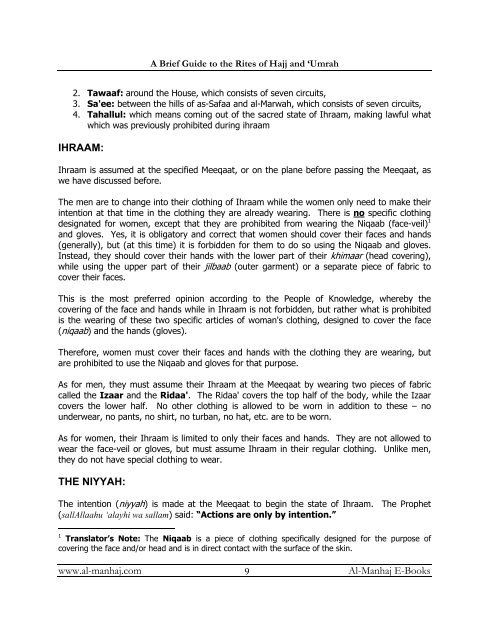

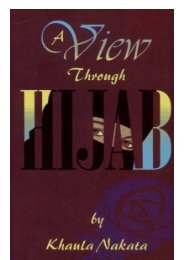
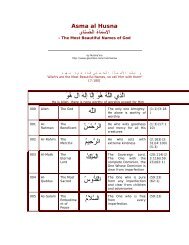
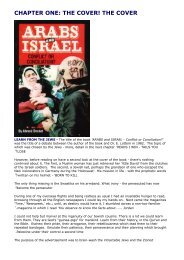



![Al-Quran - The Miracle of Miracles [ deedat]](https://img.yumpu.com/4137688/1/190x245/al-quran-the-miracle-of-miracles-deedat.jpg?quality=85)





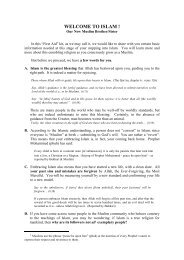
![A Collection Of Wise Sayings [ Al-Fawaid ].pdf](https://img.yumpu.com/4135801/1/190x245/a-collection-of-wise-sayings-al-fawaid-pdf.jpg?quality=85)
